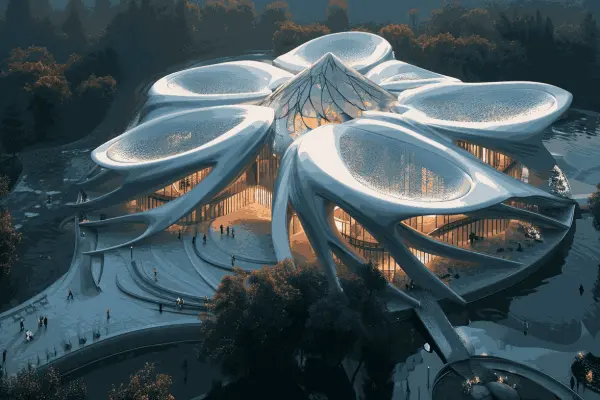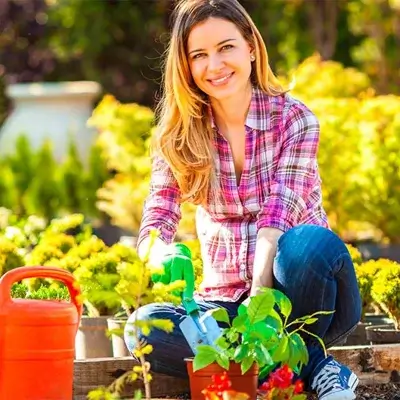Imagine a house where every element of the exterior space creates an unbreakable connection between the home and nature. Now imagine that such an eco-friendly exterior reduces your electricity bills by 25% and increases property value by 15-20%. Biophilic design is not just a trendy buzzword, but a scientifically proven approach to creating spaces that improve our physical and mental health. Integrating nature into home exteriors through biophilic elements can reduce stress levels by 10-15% and improve the quality of life for the entire family. Ready to transform your home into an oasis of harmony with nature that works for you?
What is Biophilic Design and the Role of Nature in Home Design
.jpg) Every day we spend up to 90% of our time indoors, losing connection with nature. The paradox of modern life is that the more we distance ourselves from the natural environment, the more our health suffers. Sustainable exterior design is based on the human genetic need for contact with natural elements. This concept, introduced by biologist Edward Wilson in 1984, suggests that we are biologically programmed to seek natural environments.
Every day we spend up to 90% of our time indoors, losing connection with nature. The paradox of modern life is that the more we distance ourselves from the natural environment, the more our health suffers. Sustainable exterior design is based on the human genetic need for contact with natural elements. This concept, introduced by biologist Edward Wilson in 1984, suggests that we are biologically programmed to seek natural environments.
In the context of green architecture, this means creating an organic transition between indoor and outdoor spaces, where nature in home design becomes an integral part of the building. Most importantly - it works: the impact of nature on health is evident - residents of such homes are 30% less likely to get sick and 15% more productive at work.
"The biophilic approach in construction is not a luxury, but a necessity. Research shows that people living surrounded by natural elements are 26% better at tasks requiring concentration. The benefits of facade greening go far beyond aesthetics - it's real savings and improved quality of life."
Natural home design goes beyond simple landscaping. Biophilia in architecture involves a comprehensive approach: from choosing eco-friendly materials to creating micro-ecosystems on your property. Biophilic home design requires attention to detail and understanding how natural elements work together. Let's look at specific examples of biophilic homes and ways to implement these principles in your own project.
Green Home Facades: Installing Green Walls on Facades
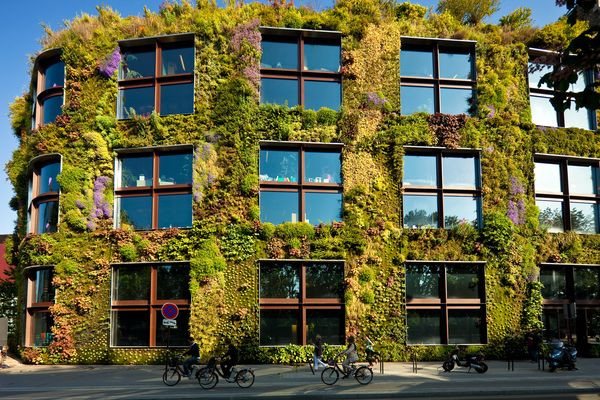 Living walls on facades are one of the most effective ways to use plants in exteriors. Vertical gardens not only transform the building's appearance but also serve many practical functions. Energy savings in biophilic homes reach 10-15% just from reducing wall temperatures in summer. Additionally, green walls improve sound insulation by 30% and create additional habitat for birds and beneficial insects.
Living walls on facades are one of the most effective ways to use plants in exteriors. Vertical gardens not only transform the building's appearance but also serve many practical functions. Energy savings in biophilic homes reach 10-15% just from reducing wall temperatures in summer. Additionally, green walls improve sound insulation by 30% and create additional habitat for birds and beneficial insects.
Biophilic landscaping services are becoming increasingly in demand, and not by chance. According to research on green facade benefits, vertical greening can also reduce particulate matter concentration in the air by 60%, which is especially important for homes in urban environments. The cost of biophilic design varies depending on the chosen system and project scale.
Vertical Greening Systems: From Simple to Complex
The biophilic approach in construction offers various exterior greening options. System choice depends on budget, climate, and desired results. Let's consider the main types of systems for creating green home facades:
- Modular systems - ready-made panels with pockets for plants, cost from $150/m². Suitable for quick installation and easy plant replacement. Equipped with automatic drip irrigation. Ideal for those wanting instant results.
- Cable systems - tensioned steel cables or meshes for climbing plants, from $30/m². Ideal for ivy, clematis, wisteria. Require 2-3 years for complete facade coverage but create a natural look.
- Hydroponic walls - soilless systems with nutrient solution, from $300/m². Allow growing over 200 species of plants, including herbs and vegetables. Require minimal maintenance due to automation.
The right exterior greening system not only beautifies your home but also creates additional insulation, improves microclimate, and increases property value. For professional installation, you can order biophilic design from specialized companies.
Step-by-Step Guide to Installing a Vertical Garden
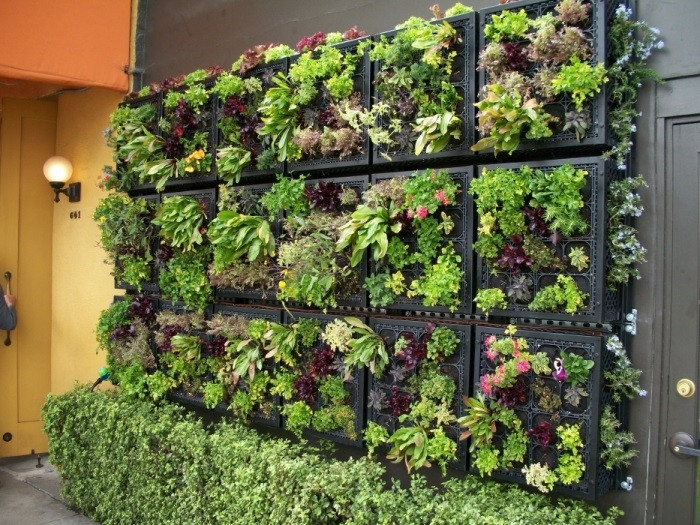
- Assessment of wall load-bearing capacity
- Check if the wall can support additional 30-60 kg/m²
- Engineer consultation is mandatory for older homes
- Consider the weight of wet soil (2-3 times heavier than dry)
- Facade waterproofing
- Apply waterproof membrane to the wall
- Install drainage layer between wall and greening system
- Provide for excess water drainage
- Choosing and installing mounting system
- Determine system type based on budget and goals
- Install supporting structure with 5-10 cm gap from wall
- Check mounting reliability
- Selecting plants for your climate zone
Proper plant selection is key to vertical greening success. Here are recommendations for different climate zones:
| Climate Zone | Minimum Temperature | Recommended Plants | Care Features | Plant Cost |
|---|---|---|---|---|
| Very Cold Climate | To -40°C | Virginia creeper, Russian vine | Winter root zone protection, spring pruning of dead shoots | $10-15 per seedling |
| Cold Climate | -25 to -30°C | Common hop, kiwi vine, bittersweet | Mulching around base, wind protection | $15-20 per seedling |
| Moderate Climate | -10 to -20°C | English ivy, clematis, honeysuckle | Watering 2-3 times weekly in summer, spring and fall fertilizing | $20-30 per seedling |
| Warm Climate | To -5°C | Wisteria, trumpet vine, passionflower, bougainvillea | Regular watering, midday sun protection, formative pruning | $25-40 per seedling |
| Hot Climate | Above 0°C | Philodendron, pothos, monstera, ficus | Daily watering, misting, protection from direct rays | $30-50 per plant |
Remember: native plant varieties are always more resilient and require less care than exotic species.
Natural Materials in Design: Natural Textures in Exteriors
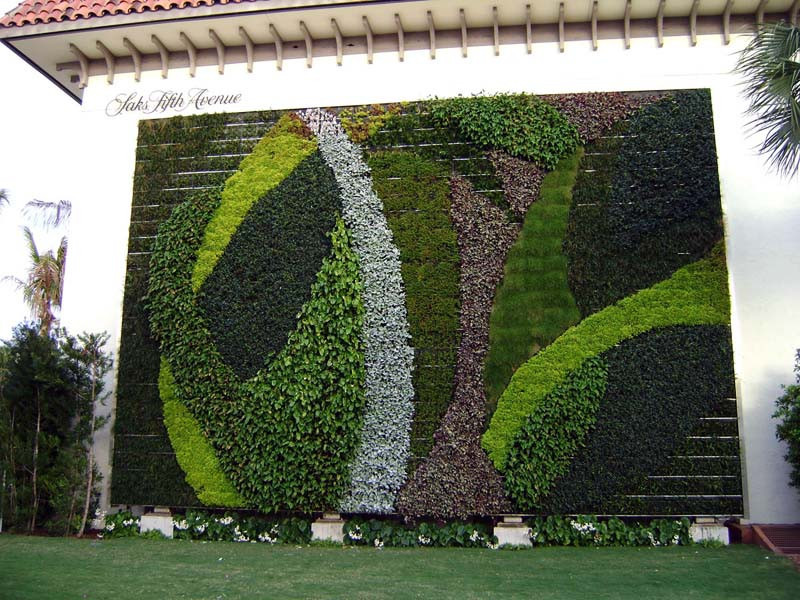 Using plants in exteriors is just part of the biophilic approach. Eco-friendly building materials for homes create tactile and visual connection with nature. Textures of wood and stone, bamboo, cork - these materials are not only ecological but age beautifully, acquiring unique character and patina over time.
Using plants in exteriors is just part of the biophilic approach. Eco-friendly building materials for homes create tactile and visual connection with nature. Textures of wood and stone, bamboo, cork - these materials are not only ecological but age beautifully, acquiring unique character and patina over time.
Choosing natural materials isn't just about aesthetics. Research shows that tactile contact with natural textures reduces stress levels and improves emotional state. Additionally, many natural materials have unique properties: they regulate humidity, provide natural insulation, and create a healthy microclimate.
Practical Solutions with Natural Materials
Sustainable exterior design is impossible without proper material selection. Natural textures in exteriors create harmony with nature and ensure construction durability. Where to buy materials for biophilic exteriors and which options to choose:
- Thermally modified wood - wood treated at high temperature, resistant to moisture and pests. Ideal for facades in regions with temperature fluctuations. Service life - 30+ years without additional treatment. Cost: $80-120/m².
- Locally sourced natural stone - sandstone, limestone, granite. Reduces transportation carbon footprint. Creates visual connection with local landscape. Excellent heat accumulation. Price: $50-150/m² depending on type.
- Bamboo panels - stronger than oak, rapidly renewable resource (grows in 3-5 years). Suitable for canopies, partitions, decorative elements. Resistant to moisture and insects. Price from $40/m².
- Cork oak bark - excellent insulator, sound-absorbing material. Used for accent walls and decorative panels. Harvested without harming trees. Price: $70-90/m².
- Untreated wood from local species - pine, larch, oak. With proper protection lasts decades. Creates authentic look. Price: $30-80/m².
Combining various eco-friendly building materials for homes allows creating unique biophilic design that will delight the eye and serve for decades. Nature in home design begins with choosing the right materials.
Water Elements in Exteriors: From Fountains to Rain Gardens
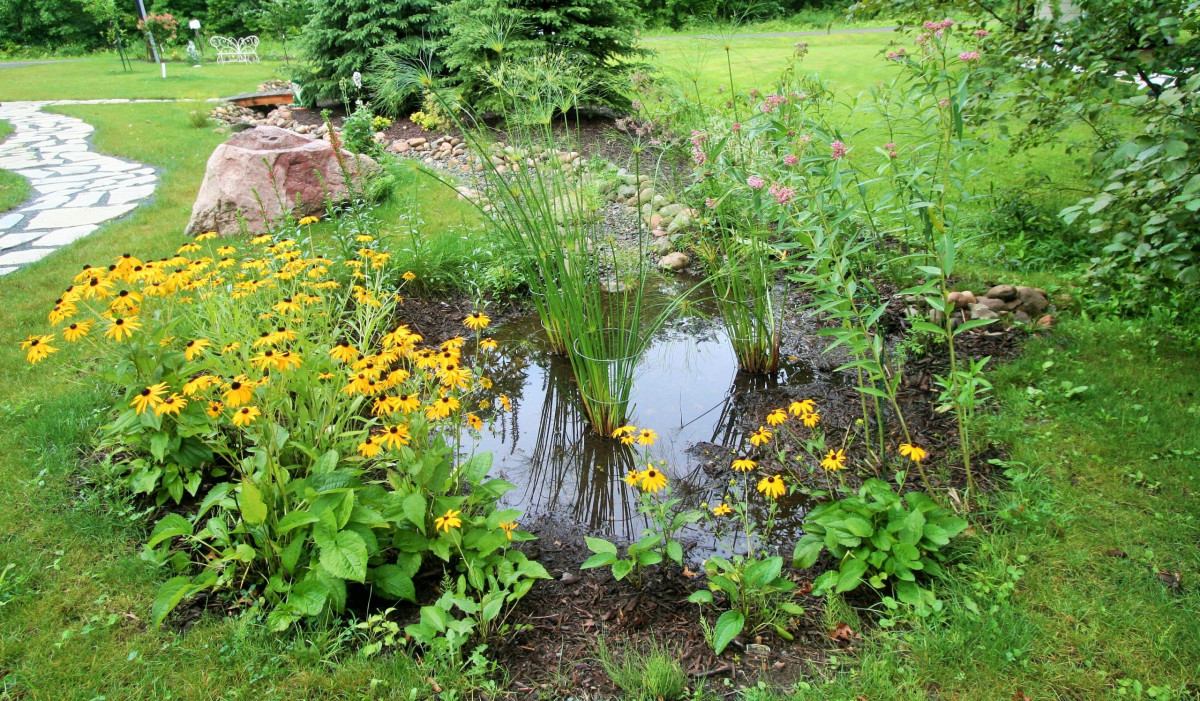 Water is one of the key elements of biophilic spaces. The sound of flowing water creates a calming atmosphere, masks urban noise, and promotes meditation. Water elements in exteriors can range from small tabletop fountains to full-scale ponds with fish and aquatic plants. It's important to understand that water in biophilic design is not just a decorative element, but a functional part of the home's ecosystem.
Water is one of the key elements of biophilic spaces. The sound of flowing water creates a calming atmosphere, masks urban noise, and promotes meditation. Water elements in exteriors can range from small tabletop fountains to full-scale ponds with fish and aquatic plants. It's important to understand that water in biophilic design is not just a decorative element, but a functional part of the home's ecosystem.
Types of Water Elements and Their Features
Water elements in exteriors are an important part of the biophilic approach in construction. They create microclimate, improve space acoustics, and serve as focal points in the landscape. Let's consider the main options for integrating water into natural home design:
- Cascading waterfalls - create white noise effectively masking street sounds. Can be integrated into retaining walls or installed as standalone elements. Require 50-100W pump. Installation cost: $2000-5000.
- Rain gardens - biofiltration systems collecting runoff from roofs and filtering through soil and plant layers. Reduce stormwater system load by 30-40%. Planted with moisture-loving native plants. Cost: $1000-3000.
- Reflecting pools - shallow water bodies 10-30 cm deep, creating mirror effect. Visually increase space and double the sky. Minimal maintenance, installation possible without pump. Price: $1500-4000.
- Streams with water circulation - imitate natural watercourses. Length from 5 meters, width 30-50 cm. Lined with river pebbles. Create dynamics in landscape. Cost: $500-1000 per linear meter.
- Bioponds - self-cleaning water bodies with aquatic plants and fish. Create complete ecosystem. Require area from 20 m². Cost: $200-400/m².
Choosing the appropriate water element depends on plot size, climate, and your budget. Professional biophilic home design always includes competent integration of water features for maximum effect.
Practical Tips for Creating Water Elements
- Start with water balance calculation - how much water will evaporate and how often refilling is needed
- Install auto-refill system to compensate for evaporation
- Use local aquatic plants - they're better adapted to climate
- Plan for winter maintenance or system conservation
- Install leaf fall protection - nets or skimmers
Rooftop Garden: Benefits and Features of Green Roofs
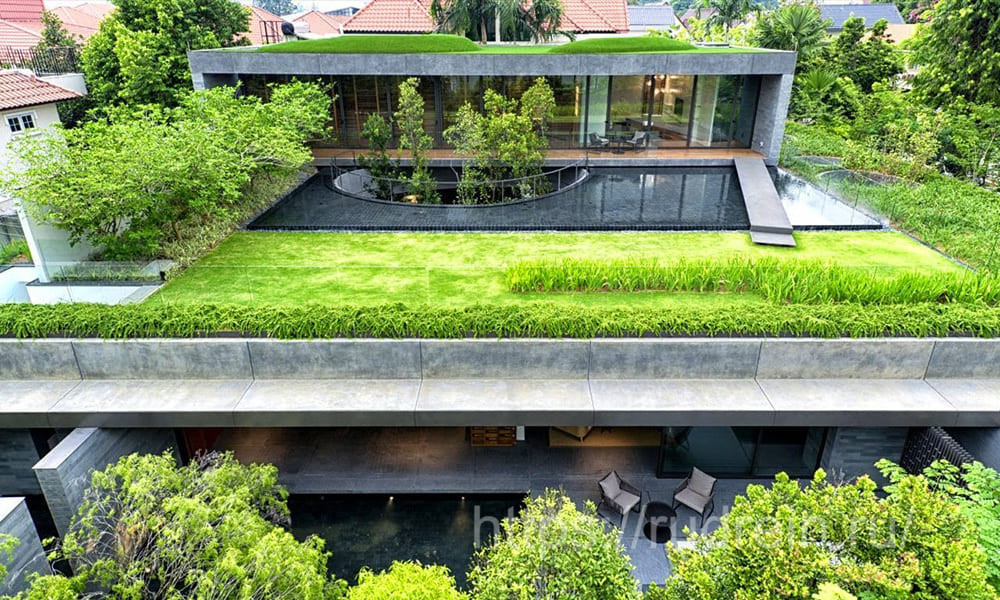 A rooftop garden is not just an aesthetic solution, but an effective way to improve building energy efficiency. Green roofs provide significant energy savings - up to 15% on cooling in summer and up to 10% on heating in winter. Additionally, they extend roofing material life 2-3 times, protecting it from UV radiation and temperature fluctuations.
A rooftop garden is not just an aesthetic solution, but an effective way to improve building energy efficiency. Green roofs provide significant energy savings - up to 15% on cooling in summer and up to 10% on heating in winter. Additionally, they extend roofing material life 2-3 times, protecting it from UV radiation and temperature fluctuations.
As shown by biophilic design examples from Urban Land Institute, properly designed green roofs can become full-fledged spaces for relaxation, work, and even growing produce. However, it's important to consider green roof disadvantages: need for regular maintenance, leak risk with improper installation, and significant initial investment.
Types of Green Roofs: Choosing the Optimal Option
- Extensive roofs - substrate 5-15 cm, sedums and mosses. Weight 60-150 kg/m². Watering only during drought. Cost $100-150/m². Suitable for sloped roofs up to 45°. Minimal care - drainage check once a year.
- Semi-intensive - substrate 15-25 cm, grasses, perennials, small shrubs. Weight 150-300 kg/m². Require periodic watering. Cost $150-250/m². Possibility of creating diverse compositions.
- Intensive gardens - substrate 25+ cm, trees, shrubs, vegetable beds. Weight 300+ kg/m². Regular care like ordinary garden. Cost $250-400/m². Require building structure reinforcement.
- Biosolar roofs - combination of green roof with solar panels. Plants cool panels, increasing efficiency by 16%. Double benefit - energy and greening. Cost from $500/m².
Green Roof Construction: Layer by Layer
Proper installation of green walls on facades and roofs requires understanding the multilayer construction. Each layer performs its function in creating reliable biophilic exterior:
- Load-bearing structure - must withstand additional load
- Waterproofing - root-resistant membranes (EPDM, TPO)
- Protective layer - geotextile to protect waterproofing
- Drainage layer - expanded clay, special mats
- Filter layer - prevents drainage clogging
- Substrate - special lightweight mixture
- Plants - selected for roof type
Despite construction complexity, properly installed green roof serves for decades, providing energy savings biophilic home can receive year-round.
Bionic Home Style: Biomimicry in Architecture
 Bionic home style involves copying natural forms in design. Curved lines, organic forms, fractal patterns - all create visual harmony and psychological comfort. Biomimicry in architecture can manifest in canopies resembling leaves, or in facade structure imitating honeycomb. Biophilic landscape design also actively uses biomimicry principles.
Bionic home style involves copying natural forms in design. Curved lines, organic forms, fractal patterns - all create visual harmony and psychological comfort. Biomimicry in architecture can manifest in canopies resembling leaves, or in facade structure imitating honeycomb. Biophilic landscape design also actively uses biomimicry principles.
Green architecture has created optimal solutions for numerous tasks over millions of years of evolution. Architects and designers increasingly turn to these solutions, creating not only beautiful but functional biophilic spaces. Biophilic landscape design actively uses these principles to create sustainable ecosystems.
Practical Examples of Biomimicry in Exteriors
- Sun protection elements based on leaf principles - automatically rotating panels following sun like sunflowers. Reduce cooling energy consumption by 30%. System cost: $200-400/m².
- Termite mound ventilation systems - passive ventilation through wall channel system. Maintains comfortable temperature without air conditioners. Energy savings up to 40%.
- Honeycomb structure - hexagonal modules for facades and partitions. Maximum strength with minimal material use. 30% structure weight reduction.
- Shell spiral forms - stairs and ramps with golden ratio. Create sense of natural movement and harmony. Improve space acoustics.
- Tree fractal patterns - branching supports and canopies. Efficient load distribution and natural water drainage. 20% material intensity reduction.
Modern 3D printing and parametric design technologies allow creating complex organic forms with millimeter precision, making biomimicry more accessible for implementation.
Exterior Landscaping: Creating Functional Biophilic Zones
Property landscaping should create smooth transition and strengthen home's connection with nature. Multi-layered plantings combining trees, shrubs, and ground covers create natural ecosystem supporting biodiversity and requiring minimal care.
Using native plant species is not only ecological but economically beneficial - they're better adapted to climate, get sick less often, and require less water. The impact of nature on health through proper landscaping is proven by numerous studies. For those wanting to create biophilic design DIY, it's important to start with simple elements and gradually expand the project.
Functional Zones of Biophilic Garden
Creating biophilic spaces requires thoughtful approach to zoning. Each zone should perform its function, maintaining home's connection with nature. Modern biophilic design offers the following functional zone options:
- Edible landscape - fruit trees, berry bushes, vegetable beds. Provide fresh produce and attract beneficial insects. Popular options: columnar apple trees, currants, gooseberries, strawberries, cherry tomatoes, herbs.
- Sensory gardens - plants with various textures, aromas, sounds. Lavender for scent, ornamental grasses for rustling, sage for tactile sensations. Create multi-sensory experience.
- Rain gardens - drought-resistant plants around water collection zones. Echinacea, rudbeckia, sedge create beautiful compositions and filter water. Solve plot flooding problems.
- Wildlife zones - unmowed areas with native plants. Attract birds, butterflies, bees. Include insect houses, feeders, water stations. Minimal care.
- Meditative spaces - secluded zones with calming plants. Japanese maple, bamboo, hosta create peaceful atmosphere. Water elements enhance effect.
Competent property landscaping considering functional zones allows creating eco-friendly home living in harmony with surrounding environment. For professional design, you can get biophilic exterior consultation from landscape designers.
Natural Home Lighting and Natural Colors in Exteriors
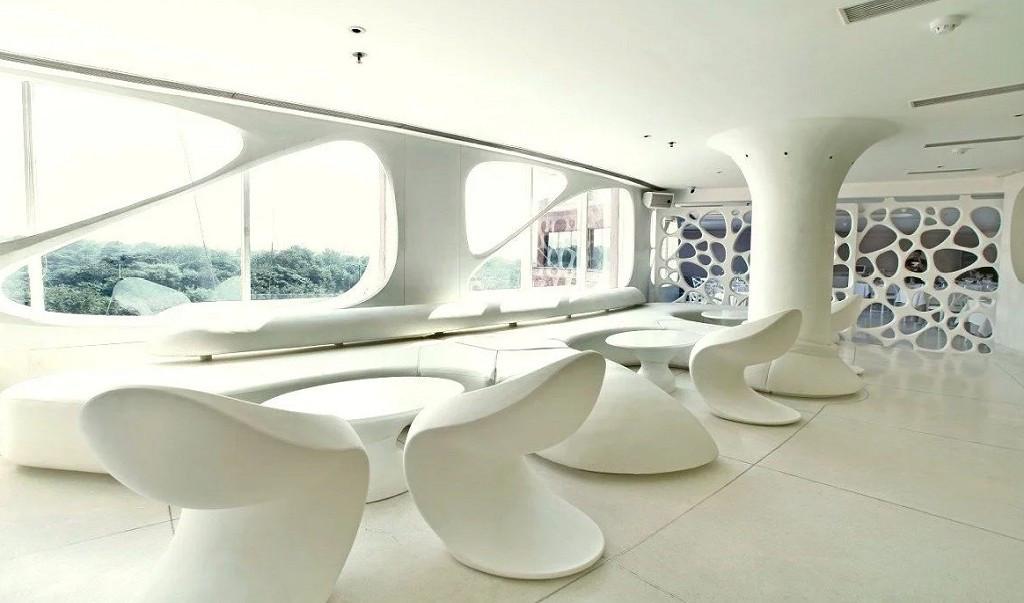 Natural home lighting plays key role in biophilic design. Properly designed windows, light wells, and reflective surfaces maximize daylight use. Natural colors in exteriors - earthy tones, green shades, sky blue - create visual connection with surrounding environment and improve residents' psychological state.
Natural home lighting plays key role in biophilic design. Properly designed windows, light wells, and reflective surfaces maximize daylight use. Natural colors in exteriors - earthy tones, green shades, sky blue - create visual connection with surrounding environment and improve residents' psychological state.
Effective Solutions for Natural Lighting
- Light shelves - horizontal reflectors above windows directing light deep into rooms. Increase illumination by 40% without glare. Reduce artificial lighting need.
- Solar tubes - light guides 25-50 cm diameter for interior room lighting. Equivalent to 300-watt lamp with zero energy consumption. Installation: $500-1500 per unit.
- Nature's color palette - ochre, terracotta, sandy shades for walls. Olive, emerald tones for accents. Sky blue for canopies. Create psychological comfort.
- Dynamic glazing - electrochromic glass changing transparency. Block up to 98% solar radiation while maintaining visibility. Cost: $100-200/m².
- Biodynamic lighting - LED systems imitating daily rhythms. Warm tones morning and evening, cool during day. Support body's circadian rhythms.
Proper use of light and color can reduce electricity consumption for lighting by 50-75% and improve residents' circadian rhythms.
7 Common Mistakes When Creating Biophilic Exteriors
- Ignoring climate - choosing unsuitable plants leads to their death in first winter. Solution: use native species and consider hardiness zone.
- Skimping on waterproofing - leaks and mold destroy structures. Solution: invest in quality materials and professional installation.
- Lack of drainage - water stagnation leads to root rot and foundation damage. Solution: plan water drainage system at design stage.
- Incorrect load calculation - risk of structure collapse. Solution: consult structural engineer.
- Forgotten maintenance plan - neglected look after just one year. Solution: create care schedule and budget for maintenance.
- Non-compliance with regulations - fines and dismantling requirements. Solution: study local building codes and obtain necessary permits.
- Unsuitable plants - constant replacement and additional costs. Solution: choose plants by principle "right plant in right place".
Success story: A Texas family implemented biophilic design in stages. First year - vertical greening of south wall ($3000). Second year - rain garden ($2000). Third year - green roof over garage ($5000). Result: $2400/year savings on utilities, home sold 18% above market price after 5 years. "We started small and moved gradually. Each improvement brought visible results," shares the homeowner. Total biophilic design cost was $10000 and paid off in 4 years.
If you're ready to start your journey toward creating biophilic exterior, you can order turnkey biophilic design from specialized companies or begin with small DIY projects. Biophilic design cost varies depending on project scale, but investments pay off in 3-5 years. The main thing is taking the first step toward harmony with nature.
Conclusion: Your Path to Biophilic Design
Biophilic design is a practical solution for creating healthy and energy-efficient home. Integrating nature into exteriors not only improves quality of life but brings real economic benefits. From simple exterior landscaping to complex green architecture systems - each element contributes to creating harmonious space.
You can start small: install vertical greening on one wall, create small water element, or use natural materials in finishing. Gradually expanding the project, you'll create full-fledged biophilic spaces that will serve your family for years.
If you're ready to take the next step, consider getting professional biophilic exterior consultation. Specialists will help develop project considering your plot and climate features. For large-scale projects, you can order turnkey biophilic design - from planning to implementation.
Remember: every plant, every natural material, every water element brings you closer to creating eco-friendly home living in harmony with nature. Start today, and within a year you'll see first results - both in utility bills and improved well-being of the entire family.
